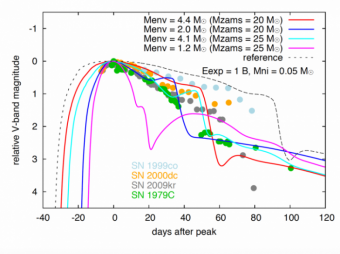 The authors of today’s paper are interested in shedding light on what attributes of the star lead to the features we see in these types of supernovae, called Type II-L supernovae (where the “L” stands for “Linear”, as in linear decay).
The authors of today’s paper are interested in shedding light on what attributes of the star lead to the features we see in these types of supernovae, called Type II-L supernovae (where the “L” stands for “Linear”, as in linear decay).
The authors combine two popular programs to generate fake supernova light curves. First, they generate a progenitor star using the a program called MESAstar. Using this simulation, they’re able to change the amount of mass a star loses over its lifetime to beef-up that star’s outer hydrogen envelope. When their stars are ready to explode, they pass them off to another program known as STELLA. STELLA follows packets of atoms to see how they mix and heat during the supernova explosion. STELLA lets astronomers see these interactions at different frequencies, so they can map the results onto filters we can observe, like the V-band. Figure 2 shows some of the light curves the authors get from STELLA and how they compare with real Type II-L supernovae.
Read the full article in Astrobites

